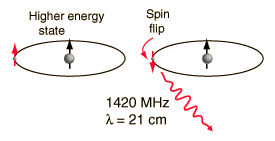My friend and colleague Greg has the coolest thesis topic ever. He used to be my office mate and we had the same supervisor for our first graduate research projects. I was doing a numerical project, which involved running simulations of dark matter particles clustering and doing lots of statistics on their power spectra... maybe another story for another day. Anyway, most of my work was done sitting at a computer in my office, running code. Greg, on the other hand, was smart enough to choose the observational project, which would land him several free trips to India.
To understand Greg's project, I guess we should first go over a brief history of the universe, which began 13.7 billion years ago. In the beginning, and for the first few hundred thousand years, the universe was filled with a hot dense plasma, that is, a gaseous state where the electrons are separated from the nuclei in most of the atoms. In this state, light couldn't travel very far because the photons were easily scattered by all the free electrons. As the universe expanded, it eventually became cool enough for the free electrons to recombine with their atoms, and all the light that had been bouncing around between these electrons was allowed to escape. We call this light, now red-shifted to the microwave part of the electromagnetic spectrum, the
Cosmic Microwave Background.
For a while after this, the universe was pretty boring. For a few hundred million years, it was filled with this neutral hydrogen gas, which slowly started to clump together into what would become the first structures in the universe. Astronomers like to call this time the "dark ages" because there was no new light being produced. Eventually, the first stars formed from the collapse of hydrogen gas and there was again a source of photons in the universe. This new source of energy caused all the neutral hydrogen gas to again become ionized, and the electrons were once again separated from their nuclei, but now, since the universe had expanded and cooled considerably, light could travel long distances without being scattered. We call this the
Epoch of Reionization.
Here's a pretty picture, shamelessly stolen from Wikipedia (and before that from the WMAP site, I think), which nicely illustrates this history of the universe:
My friend Greg is actually trying to observe this transition, to basically get a picture of the universe as it changed from neutral hydrogen to ionized hydrogen. But how, you may ask, would you be able to distinguish this neutral gas from its ionized counterpart? Well, it turns out that it's very difficult and necessitates the exploitation of quantum mechanics.
Neutral hydrogen is made up of an electron orbiting around a proton nucleus. These subatomic particles have something called "spin", which has to do with their angular momentum. When the spins of the electron and proton are aligned, the atom is in a slightly higher energy state than when they are anti-aligned. Thus, there is a very small probability (something like 0.000000000000003 times per second) that the electron will change its spin, and give off a low-energy photon. Here's a picture illustrating this from
Hyperphysics (where you can also find out more details about this transition):
Even though this transition is extremely unlikely for a single atom, when you get a big bunch of neutral hydrogen together, it happens quite often. The emission of 21-cm radiation from neutral hydrogen gas has helped us map out this gas in our galaxy and in other galaxies. And Greg is looking for the 21-cm emission from the neutral hydrogen at reionization as it started to change into ionized gas, a process that would have happened gradually, in clumps around the first stars. Computer simulations seem to indicate that it would look something like this, where the ionized gas is indicated in orange, and the neutral gas in green:
Now, this 21-cm radiation is visible to radio telescopes, which is why Greg got to go to India... He went to the
GMRT (Giant Metrewave Radio Telescope) array, near Pune, which is the largest radio dish array for metre-wavelength range of radiation. He keeps telling me that India isn't so great, but when I see pictures like this (taken in the middle of winter, no less), I can't help but be a little envious:
A lot of his time there has been spent looking for radio interference on the ground, caused by transformers, power line junctions, and loose wires in contact with power lines, and finding these means spending a lot of time wandering around in a farmer's field with a goofy-looking radio-wave receiver:
Unfortunately, the 21-cm signature of reionization is still much fainter than the foreground sources from the ground and in space, and so Greg hasn't been able to detect it yet. He did, however put some upper limits on its power spectrum, which you can read all about in his
most recent paper!
P.S. Pictures from India provided by Greg himself.


















































